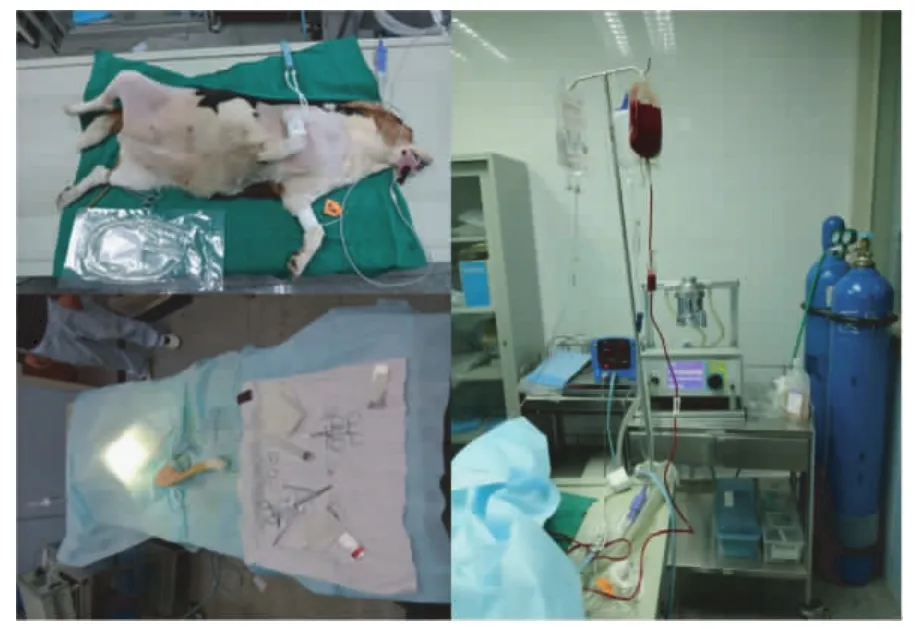急性血液稀释技术在动物实验围手术期中的应用
2015-05-11朱泽兴张树明赵永军樊凯彬
朱泽兴,张树明,赵永军,樊凯彬,乔 林
(1.解放军第二炮兵总医院骨科,北京 100088;2.武警医学院附属医院骨科,天津 300160;3.邯郸市中心医院骨科,邯郸河北 056001)
急性血液稀释技术在动物实验围手术期中的应用
朱泽兴1,张树明1,赵永军2,樊凯彬3,乔 林1
(1.解放军第二炮兵总医院骨科,北京 100088;2.武警医学院附属医院骨科,天津 300160;3.邯郸市中心医院骨科,邯郸河北 056001)
目的观察急性血液稀释技术(ANH)在狗断肢冷冻再植实验中对改善术中、术后动物全身状态的作用。方法 在狗后肢深低温冷冻再植实验中,对照组(A组)采用静脉补充等量乳酸钠林格氏液,实验组(B组)采用急性血液稀释技术,对比两组各时点循环动力学指标、血常规、术后动物苏醒时间、抬头时间、站立时间、术后进食、进水时间。结果 ①术中两组PaO2、PCO2值均在正常范围,呼吸频率正常,B组心率明显低于A组,术中血红蛋白、红细胞压积输血前A组与B组无统计学差异,术后B组明显高于A组,差异存在显著性。②术后动物苏醒时间、抬头时间、站立时间、术后进食量、进水量B组均明显优于A组,存在显著差异。结论 在狗断肢深低温冷冻再植实验中,急性血液稀释技术(ANH)能明显改善动物术中的全身状态,加快术后恢复速度。
自体输血;急性血液稀释技术(ANH);断肢再植;冷冻保存;外科手术
复杂手术动物实验往往手术时间长、创伤大、出血多,容易造成术中、术后动物休克死亡而使实验失败。由于目前尚无实验动物异体血库,无法进行异体输血,所以我们在狗后肢深低温冷冻再植实验中,引入了急性血液稀释技术(ANH),对比术中、术后动物血液循环动力学指标及全身状态,报告如下:
1 材料和方法
1.1 一般资料
选择成年实验用比格犬16只,实验动物由北京维通利华实验动物技术有限责任公司提供。动物许可证号:SCXK(京)2011-0006。雌雄各半,体重(15±0.5)kg,随机分为A、B两组,对照组(A组)采用静脉补充等量乳酸钠林格氏液,实验组(B组)采用急性血液稀释技术。在解放军军事医学科学院实验室操作,实验动物使用合格证号:SYXK-(军)2012-0021。实验过程中对动物处置方法符合《关于善待实验动物的指导性意见》。
1.2 手术过程
术前40 min B组采犬静脉血150 mL,同时输注乳酸钠林格氏液250 mL,A组不采血,直接输注乳酸钠林格氏液100 mL;术前10 min检测A、B两组血压、心率、呼吸、血红蛋白、红细胞压积。经口腔插管全身麻醉成功后,常规消毒铺巾,自犬胫腓骨中远1/3处离断,将肢体远端灌注后阶梯式降温至-196摄氏度,存放1 h后再阶梯式复温至常温,行断肢再植手术,A、B两组手术操作相同,手术结束前30 min检测A、B两组血压、心率、血红蛋白、红细胞压积,心电图(EKG),氧饱和度(SpO2),而后将B组术前所采自体血回输;同时A组输注乳酸钠林格氏液150 mL,手术历时约7 h,全部实验组均由同一组手术人员执行,术后60 min复测上述指标(图1)。

图1 左上:实验动物及血袋;(upper left),preoperative preparation(lower left),and post-operation blood transfusion(right)Fig.1 The experimental animal and blood bag
1.3 观察指标
1.3.1 术前:术前10 min、检测A、B两组血压、心率、呼吸、血红蛋白、红细胞压积。
1.3.2 术中:手术结束前30 min,检测A、B两组血压、心率、血红蛋白、红细胞压积,心电图(EKG),氧饱和度(SpO2)。
1.3.3 术后:术后60 min,检测A、B两组血压、心率、呼吸、血红蛋白、红细胞压积,同时观察记录A、B组动物术后苏醒时间,抬头时间,站立时间,术后首日进食量(实验动物饲料克)、进水量(mL)。
1.4 统计学方法
表1 术前10 min监测指标(±s)Tab.1 Monitoring indicators at 10 min before operation(±s)

表1 术前10 min监测指标(±s)Tab.1 Monitoring indicators at 10 min before operation(±s)
注:A、B两组血压、心率、呼吸、血红蛋白、红细胞压积p值均大于0.05,差异无显著性,认为ANH技术对犬术前状态无明显影响。Note.There was no significant difference in BP,HR,BR,Hgb and HCT between the two groups(P>0.05).ANH had no obvious effect on the dog preoperative status.
组别Groups犬臂血压BP of upper limb(mmHg)心率HR(次/分)呼吸频率BR(次/分)血红蛋白Hgb(g/L)红细胞压积HCT(%)对照组Control group(A组)155.6±4.1/68.6±7.9 102.8±6.4 38.3±3.7 177.3±4.2 48.4±0.87实验组Experiment group(B组)155.9±3.4/71.6±8.5 103.4±4.6 39.6±4.4 174.4±2.9 47.5±0.89 p值0.895 0.825 0.508 0.138 0.63
表2 手术完成前30 min监测指标(±s)Tab.2 Monitoring indicators at 30 mins before the completion of operation(±s)

表2 手术完成前30 min监测指标(±s)Tab.2 Monitoring indicators at 30 mins before the completion of operation(±s)
注:A、B两组血压、心率、血红蛋白、红细胞压积、氧饱和度p值均大于0.05,差异无显著性,认为术前用ANH处理对犬术中状态无明显影响。Note.There was no significant difference in BP,HR,BR,Hgb,HCT and SaO2 between the two groups(P>0.05).ANH had no obvious effect on the dog during the operation.
组别 犬臂血压 心率 血红蛋白 红细胞压积 氧饱和度 心电图GroupsBP of upper limbHRHgbHCTSaO2ECG(mmHg)(次/分)(g/L)(%)(%)对照组124.4±3.5/140.9±4.2 104.6±4.0 34.0±2.50 98.5±1.20 Normal Control group(A组)58.6±5.9 正常实验组123.6±3.7/140.3±5.4 104.1±3.1 32.9±2.99 98.3±1.28 Normal Experiment group(B组)56.6±6.5 正常p值 0.419 0.799 0.784 0.332 0.693 Normal正常
表3 术后60 min监测指标(±s)Tab.3 Monitoring indicators at 60 min after the complation of operation(±s)

表3 术后60 min监测指标(±s)Tab.3 Monitoring indicators at 60 min after the complation of operation(±s)
注:A、B两组血压、呼吸、氧饱和度p值均大于0.05,差异无显著性;两组心率、血红蛋白、红细胞压积p值均小于0.05,差异存在显著性,认为应用ANH技术,血液回输后实验犬术后心率明显降低,同时可明显提高术后血红蛋白及红细胞压积。Note.There was no significant difference in BP,HR and SaO2between two groups(P>0.05),but HR,Hgb,HCT in the experiment group were different from those in control group(P<0.05).It suggested that dogs in the experiment group had lower HR and higher Hgb and HCT than the control group after operation.
组别 犬臂血压 心率 呼吸频率 血红蛋白 红细胞压积 氧饱和度GroupsBP of upper limbHRBRHgbHCTSaO2(mmHg)(次/分)(次/分)(g/L)(%)(%)对照组141.4±3.6/129.1±26.4 33.9±3.0 116.0±4.2 30.1±1.70 96.4±0.9 Control group(A组)73.6±8.9实验组143.1±2.23/116.1±3.14 35.0±2.9 144.4±3.1 40.8±1.64 96.8±1.0 Experiment group(B组)74.6±9.5 p值0.261 0.000 0.467 0.000 0.000 0.456
表4 手术时间和术后动物状态(±s)Tab.4 The conditions of during operation and post-operation(±s)

表4 手术时间和术后动物状态(±s)Tab.4 The conditions of during operation and post-operation(±s)
注:A、B两组手术时间、苏醒时间p值均大于0.05,差异无显著性;两组抬头时间、站立时间、术后24h进食、水量p值均小于0.05,差异存在显著性,认为应用ANH技术,能够明显改善实验犬的术后状态,使其尽快抬头、站立、进食水,但进水量较对照组减少。Note.There was no significant difference in operation time and resuscitation time between the two groups(P>0.05),but first rising head time,first standing time and eating and drinking intake in the experiment group were different from those in of the control group(P<0.05).It suggested that dogs in the experiment group restored earlier than the control group.
组别 手术时间 苏醒时间 抬头时间 站立时间 进食量GroupsOperationResuscitationFirst rising headFirst standingEating time(h)time(min)time(min)time(h)(g)对照组6.9±0.20 13.87±0.99 68.5±13.36 3.55±0.38 269.38±25.4 Control group(A组)实验组6.9±0.24 13.1±1.36 52.9±5.13 2.49±0.22 393.8±38.9 Experiment group(B组)p值1.000 0.136 0.008 0.000 0.000
2 结果
2.1 术前
术前10 min(备血后)、检测A、B两组血压、心率、呼吸、血红蛋白、红细胞压积,各组数据应用SPSS17.0统计软件处理,采用两独立样本的t检验(表1)。
2.2 术中
两组麻醉机设置相同的呼吸频率、潮气量及氧浓度,手术结束前30 min,检测A、B两组血压、心率、血红蛋白、红细胞压积,心电图(EKG),氧饱和度(SpO2),各组数据应用SPSS17.0统计软件处理,采用两独立样本的t检验(表2)。
2.3 术后
手术结束前30 min将B组术前所采自体血回输,同时A组输注乳酸钠林格氏液150 mL;术后实验犬均顺利拔管、苏醒,术后60 min,检测A、B两组血压、心率、呼吸、血红蛋白、红细胞压积,同时观察记录A、B组动物手术时间、术后苏醒时间,抬头时间,站立时间,术后首日进食量(实验动物饲料克)、进水量(mL)。各组数据应用SPSS 17.0统计软件处理,采用两独立样本的t检验(表3、4)。
由上述结果可见,急性血液稀释技术可以有效降低术中实际出血,改善动物术后贫血,缩短动物复苏时间,使动物快速恢复到术前状态,进而保证实验的顺利进行,同时减轻了实验动物的痛苦。
3 讨论
一种创新技术、创新手术在进入临床前必须进行大量的严格的活体动物实验,而其中需要复杂手术操作的活体动物实验失败的主要原因除了手术操作失误以外,很大一部分因素是因为手术时间长、创伤大、出血多,造成动物术中、术后休克死亡,所以输血对需要复杂手术操作的活体动物实验就显得尤为重要[1-3]。但对动物输血目前只有美国、澳大利亚等发达国家以中央血库的形式建立了动物血库,目的是治疗宠物和拯救濒危动物,而非动物实验用血库[4-7];国内因为成本太高目前尚无动物血库,仅少量宠物医院采用临时同种异体输血方式对救治的宠物进行输血,但宠物品种繁多,血型也多种多样,如犬的血型至少有8种,猫有6种,羊有9种,而牛的血型多达40种以上,且无统一的检测标准,存在巨大的安全问题,更无法在动物实验中广泛应用[8-11]。
人类探索安全输血经历了长达400年的历程,随着对异体输血弊端认识的深入,人们已逐渐接受并提倡自体输血,并出现了术前自体采血贮存技术(preoperative active blood donation,PABD)、急性血液稀释技术(acute normovolemic hemodilution)、术中及术后术区血液回收技术(intraoperative and postoperative blood salvage)等自体输血技术。但目前术前自体采血贮存技术和术中及术后血液回收技术都需要专业的血液采集、储存、净化等设备,费用昂贵,难以普及。而对于难以实现异体输血的动物实验,急性血液稀释技术就成为一条重要的解决方法。
急性血液稀释技术(ANH)是1946年发明的术中自体输血的一种方式,现已广泛应用于临床[12,17]。ANH一般是在麻醉后和手术主要步骤开始之前,短时间内快速抽取患者预定量的自体血液贮存于手术间,同时补充等效容量的晶体或胶体液,快速稀释血液,有输血指征或手术结束前再将采集的新鲜自体血回输给患者[12,13,17]。其优点有:(1)ANH可使术中血液稀释,降低在手术操作过程中循环中的红细胞浓度,减少术中红细胞流失,使手术中的实际出血量减少,以达到不输异体血或少输异体血的目的[13];(2)ANH是唯一提供新鲜自体血液的方法,血小板及凝血因子功能基本不受影响,红细胞损失少;(3)自身输血,无抗原性及过敏反应的风险,对术后免疫学检查影响小[14,15,16]。
断肢冷冻再植实验手术创伤大,手术时间长,出血多,我们将ANH应用到此实验中,研究结果显示,ANH可以有效降低术中实际出血,纠正术后贫血,同时缩短动物术后抬头、站立时间,改善术后动物全身状态。
综上所述,对于需要复杂手术操作的活体动物实验,急性血液稀释技术可以有效降低术中实际出血,改善动物术后贫血,缩短动物复苏时间,使动物快速恢复到术前状态,进而保证实验的顺利进行;同时ANH减轻了实验动物的痛苦,符合动物实验伦理学的要求,操作简单,费用低廉,值得进一步推广。
[1]Tremper KK.48thAnn Reference Course Lectures and Clin Update Program Am Soc Ansthesiologists[M].1997,7:113.
[2]Klövekorn WP,Pichlmaier H,Ott E,et al.Akute praeoperative Haemodilution eine Moeglichkeit zu autologen Bluttransfusion[J].Chirurg,1974,45:452-458.
[3]Matot I,Scheinin O,Jurim O,et al.Effectiveness of acute normovolemic hemodilution to minimize allogeneic blood transfusion in major liver resections[J].Anesthesiology,2002,97(4):974-800.
[4]Gross JB.Estimating allowable blood loss:corrected for dilution[J].Anesthesiology,1983,58:277-280.
[5]Estafanous FG,Mekhail N,Yared JP.Advantages limitations of hemodilution[J].Semin Thorac Surg,1994,6:87-89.
[6]Habler OP,Kleen MS,Podtschaske AH.et al.The dffect of acute normovolemic hemodilution on myocardial contractility in anesthetized dogs[J].Analg,1996;83(2):451-458.
[7]Leung JM,Weiskopf RB,Feiner J.et al.Electrocardiographic ST-segment change during acute severe isovolemic hemodilution in humans[J].Anesthesiology,2000,93(4):1004-1010.
[8]Weiskopf RB.Hemodilution and candles[J].Anesthesiology,2002,97(4):773-775.
[9]Van Der Linden P,Wathieu M,Gilbart E,et al.Cardiovascular effects of moderate normovolaemic haemodilution during enflurane-nitrous oxide anaesthesia in man [J].Acta Anaesthesiol Scand,1994,38:490-498.
[10]Ickx BE,Rigolet M,Van der Linden PJ.Cardiovascular and metabolic response to acute normovolemic anemia[J].Anesthesiology,2000,93:1001-1016.
[11]Jones,SB,Whitten,CW,Monk,TG.Influence of crystalloid and colloid replacement solutions on hemodynamic variables during acute normovolemic hemodilution[J].J Clin Anesth,2004,16(1):11-7.
[12]牛新环,田玉科,张咸伟,等.急性等容性血液稀释与自体血回输对病人血电解质和血浆蛋白的影响[J].临床麻醉学杂志,2004,20(2):109-110.
[13]Stehling LC.A Report by the American Society of Anesthesiologists Task Force on Blood Component Therapy.PracticeGuidelines forBlood ComponentTherapy[J].Anesthesiology,1996,84:732-747.
[14]Miller RD.Coagulation and packed red cell transfusion[J].Anesth Analg,1995,80:215-216.
[15]Hobisch-Hagen P,Wirleitner B,Mair J,et al.Consequences of acute normovolaemic haemodilution on haemostasis during major orthopaedic surgery[J].Br J Anaesth,1999,82(4):505 -509.
[16]Bourke DL,Smith TC.Estimating allowable hemodilution[J].Anesthesiology,1974,41:609-612.
[17]效小莉,钱桂兰,刘岚.围产期急性等容稀释性自体输血安全性研究[J].中国输血杂志,2013,(1):63-64.
Acute normovolemic hemodilution in cryopreserved dog limb replantation
ZHU Ze-Xing1,ZHANG Shu-Ming1,ZHAO Yong-Jun2,FAN Kai-Bin3,QIAO Lin1
(1.Department of Orthopaedics,the Second Artillery General Hospital,BeiJing 100088,China;2.Department of Orthopaedics,Armed Police Medical School affiliated Hospital,Tianjin 300160;3.Department of Orthopaedics,Handan Central Hospital,Handan,Hebei 056001)
Objective To observe the contribution of acute normovolemic hemodilution(ANH)in experiment of cryopreserved dog limb replantation.Methods Sixteen healthy Beagle dogs(male:female=1:1)were divided into two groups.Dogs in the experiment group(Group B)
ANH in the limb replantation,and dogs in the control group(Group A)received the same amount of lactate Ringer’s solution intravenously during the surgical operation.We recorded and compared the hemodynamic indexes,HB,HCT,the resuscitation time,the first rising head time,the first standing time and the first eating and drinking time between the two groups.Results (1)During the operation,both PaO2and PCO2in the two groups were normal,as well as the breathing rate.The heart rate in the group B was lower than that in the group A.Before blood transfusion,there was no statistically significant difference in HB and HCT between the two groups,but after transfusion they were significantly higher in the group B than in the group A.(2)The resuscitation time,the first rising head time,the first standing time and the first eating and drinking time of the group B were all better than those in the group A.Conclusions In cryopreserved dog limb replantation experiments,acute normovolemic hemodilution is helpful to improve the general condition and facilitate the recovery of animals after limb replantation.
Dog;Limb replantation;Cryopreservation;Acute normovolemic hemodilution;Surgery
乔林(1971-),男,研究方向:创伤骨科。qiaolindoc@sohu.com。
R33
A
1671-7856(2015)04-0014-03
10.3969.j.issn.1671.7856.2015.004.003
军队“十二五”课题基金《冷冻肢体再植的研究》(编号:08G051)。
朱泽兴(1981-),男,研究方向:创伤骨科、显微外科。E-mail:zzxzxcvbn@163.com。
2015-02-15
